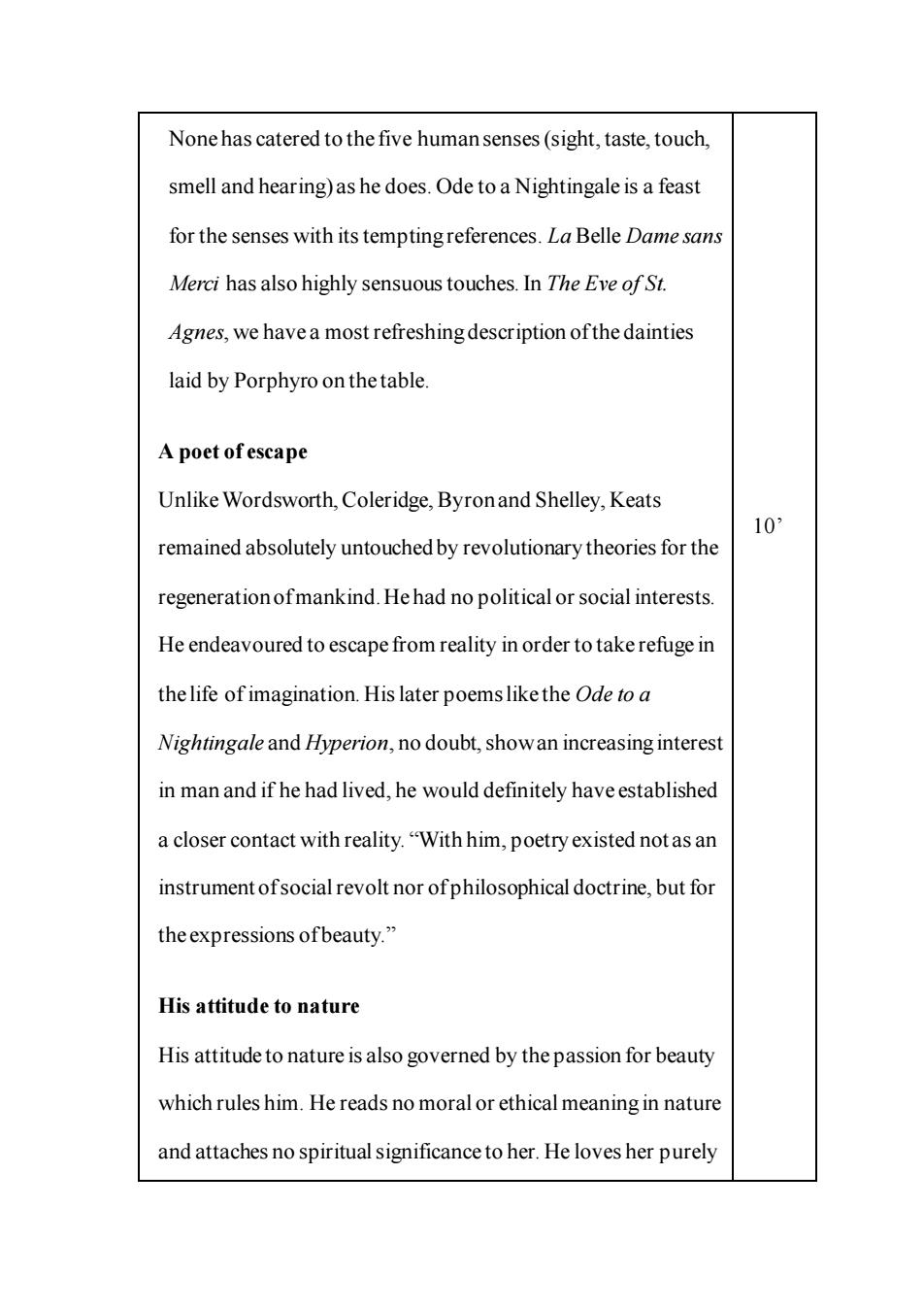
None has catered to the five humansenses(sight,taste,touch, smell and hearing)as he does.Ode to a Nightingale is a feast for the senses with its tempting references.La Belle Dame sans Merci has also highly sensuous touches.In The Eve of.St. Agnes,we have a most refreshing description ofthe dainties laid by Porphyro on thetable. A poet of escape Unlike Wordsworth,Coleridge,Byronand Shelley,Keats 10 remained absolutely untouched by revolutionary theories for the regenerationofmankind.Hehad no political or social interests He endeavoured to escape from reality in order to take refuge in the life of imagination.His later poemslikethe Ode toa Nightingale and Hyperion,no doubt,show an increasing interest in man and if he had lived,he would definitely have established a closer contact with reality."With him,poetry existed not as an instrument ofsocial revolt nor ofphilosophical doctrine,but for theexpressions ofbeauty." His attitude to nature His attitude to nature is also governed by the passion for beauty which rules him.He reads no moral or ethical meaning in nature and attaches no spiritual significance to her.He loves her purely
None has catered to the five human senses (sight, taste, touch, smell and hearing) as he does. Ode to a Nightingale is a feast for the senses with its tempting references. La Belle Dame sans Merci has also highly sensuous touches. In The Eve of St. Agnes, we have a most refreshing description of the dainties laid by Porphyro on the table. A poet of escape Unlike Wordsworth, Coleridge, Byron and Shelley, Keats remained absolutely untouched by revolutionary theories for the regeneration of mankind. He had no political or social interests. He endeavoured to escape from reality in order to take refuge in the life of imagination. His later poems like the Ode to a Nightingale and Hyperion, no doubt, show an increasing interest in man and if he had lived, he would definitely have established a closer contact with reality. “With him, poetry existed not as an instrument of social revolt nor of philosophical doctrine, but for the expressions of beauty.” His attitude to nature His attitude to nature is also governed by the passion for beauty which rules him. He reads no moral or ethical meaning in nature and attaches no spiritual significance to her. He loves her purely 10’
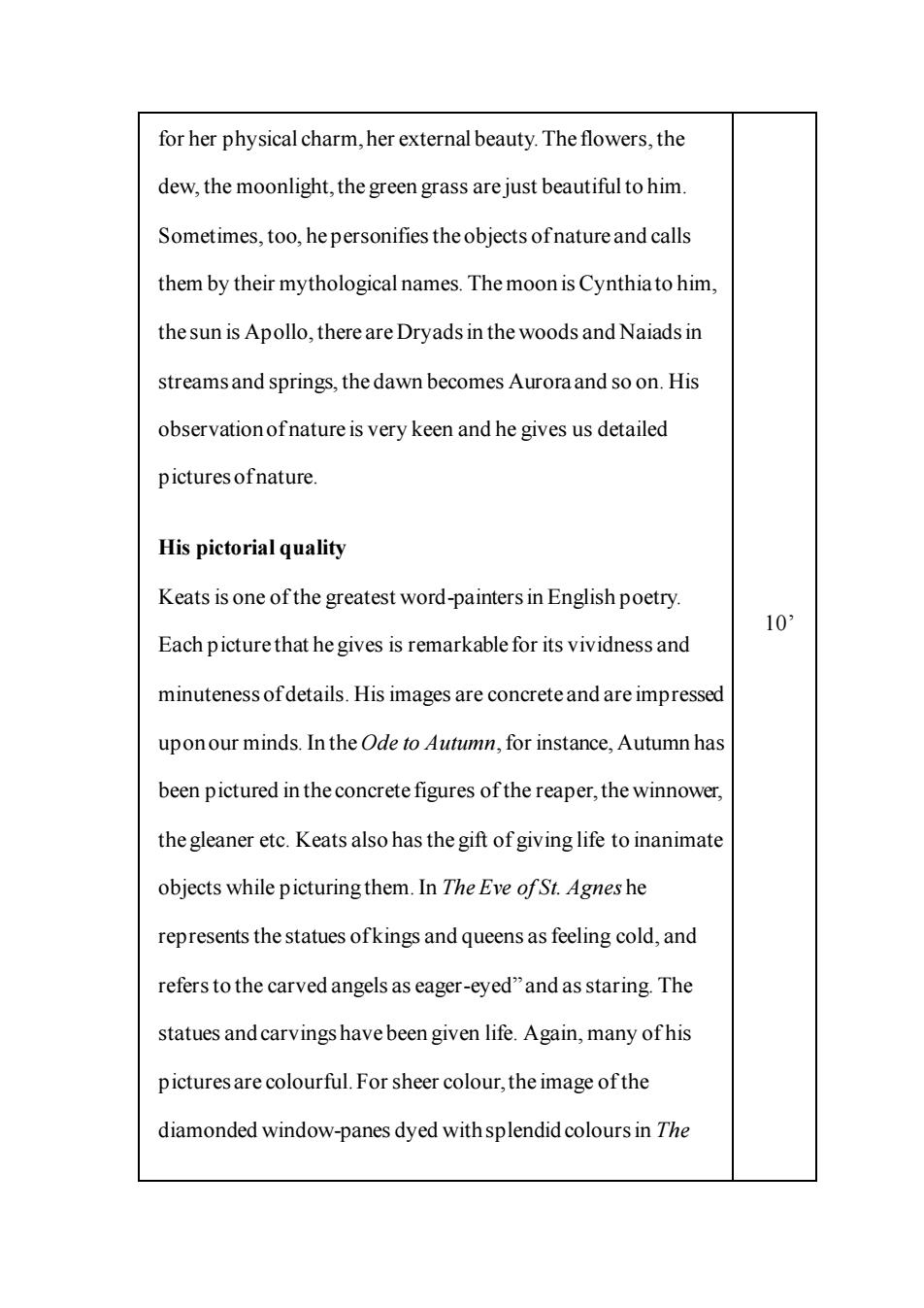
for her physical charm,her external beauty.The flowers,the dew,the moonlight,the green grass are just beautiful to him. Sometimes,too,he personifies the objects ofnature and calls them by their mythological names.The moon is Cynthiato him the sun is Apollo,there are Dryads in the woods and Naiads in streams and springs,the dawn becomes Auroraand so on.His observation ofnature is very keen and he gives us detailed pictures ofnature. His pictorial quality Keats is one ofthe greatest word-painters in English poetry. 10 Each picture that he gives is remarkable for its vividness and minuteness ofdetails.His images are concreteand are impressed upon our minds.In the Ode to Autumn,for instance,Autumn has been pictured in theconcrete figures ofthe reaper,the winnower the gleaner etc.Keats also has the gift of giving life to inanimate objects while picturingthem.In The Eve ofSt.Agnes he represents the statues ofkings and queens as feeling cold,and refers to the carved angels as eager-eyed"and as staring.The statues and carvings have been given life.Again,many ofhis picturesare colourful.For sheer colour,the image ofthe diamonded window-panes dyed withsplendid colours in The
for her physical charm, her external beauty. The flowers, the dew, the moonlight, the green grass are just beautiful to him. Sometimes, too, he personifies the objects of nature and calls them by their mythological names. The moon is Cynthia to him, the sun is Apollo, there are Dryads in the woods and Naiads in streams and springs, the dawn becomes Aurora and so on. His observation of nature is very keen and he gives us detailed pictures of nature. His pictorial quality Keats is one of the greatest word-painters in English poetry. Each picture that he gives is remarkable for its vividness and minuteness of details. His images are concrete and are impressed upon our minds. In the Ode to Autumn, for instance, Autumn has been pictured in the concrete figures of the reaper, the winnower, the gleaner etc. Keats also has the gift of giving life to inanimate objects while picturing them. In The Eve of St. Agnes he represents the statues of kings and queens as feeling cold, and refers to the carved angels as eager-eyed” and as staring. The statues and carvings have been given life. Again, many of his pictures are colourful. For sheer colour, the image of the diamonded window-panes dyed with splendid colours in The 10’
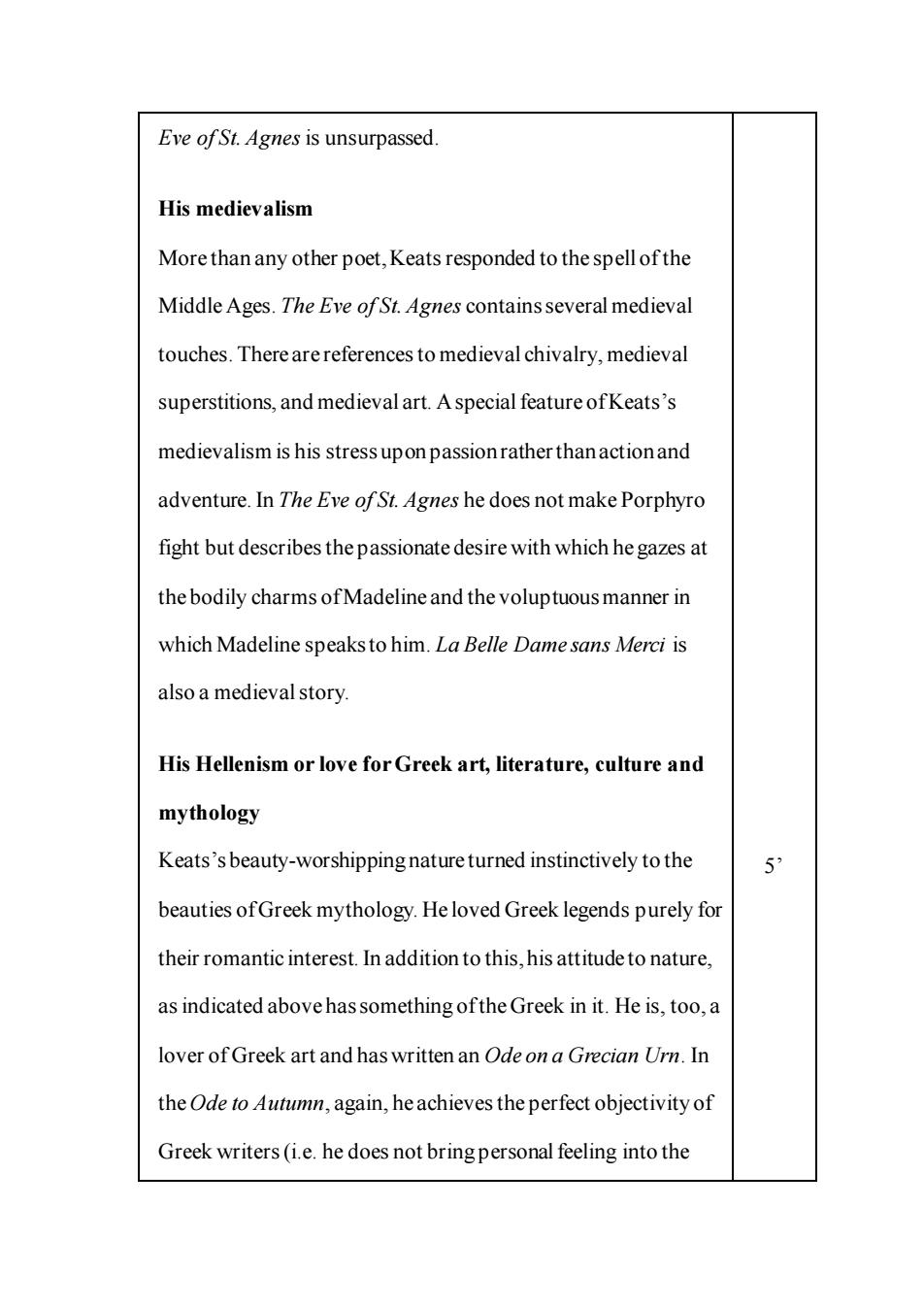
Eve ofSt.Agnes is unsurpassed. His medievalism More thanany other poet,Keats responded to the spell ofthe Middle Ages.The Eve of St.Agnes contains several medieval touches.Therearereferences to medieval chivalry,medieval superstitions,and medieval art.Aspecial feature ofKeats's medievalism is his stress upon passionrather thanactionand adventure.In The Eve ofSt.Agnes he does not make Porphyro fight but describes the passionate desire with which he gazes at the bodily charms of Madeline and the voluptuous manner in which Madeline speaksto him.La Belle Dame sans Merci is also a medieval story His Hellenism or love for Greek art,literature,culture and mythology Keats's beauty-worshipping nature turned instinctively to the 5 beauties ofGreek mythology.He loved Greek legends purely for their romantic interest.In addition to this,his attitude to nature as indicated above hassomething ofthe Greek in it.He is,too,a lover of Greek art and has written an Ode on a Grecian Urn.In the Ode to Autumn,again,heachieves the perfect objectivity of Greek writers(i.e.he does not bring personal feeling into the
Eve of St. Agnes is unsurpassed. His medievalism More than any other poet, Keats responded to the spell of the Middle Ages. The Eve of St. Agnes contains several medieval touches. There are references to medieval chivalry, medieval superstitions, and medieval art. A special feature of Keats’s medievalism is his stress upon passion rather than action and adventure. In The Eve of St. Agnes he does not make Porphyro fight but describes the passionate desire with which he gazes at the bodily charms of Madeline and the voluptuous manner in which Madeline speaks to him. La Belle Dame sans Merci is also a medieval story. His Hellenism or love for Greek art, literature, culture and mythology Keats’s beauty-worshipping nature turned instinctively to the beauties of Greek mythology. He loved Greek legends purely for their romantic interest. In addition to this, his attitude to nature, as indicated above has something of the Greek in it. He is, too, a lover of Greek art and has written an Ode on a Grecian Urn. In the Ode to Autumn, again, he achieves the perfect objectivity of Greek writers (i.e. he does not bring personal feeling into the 5’
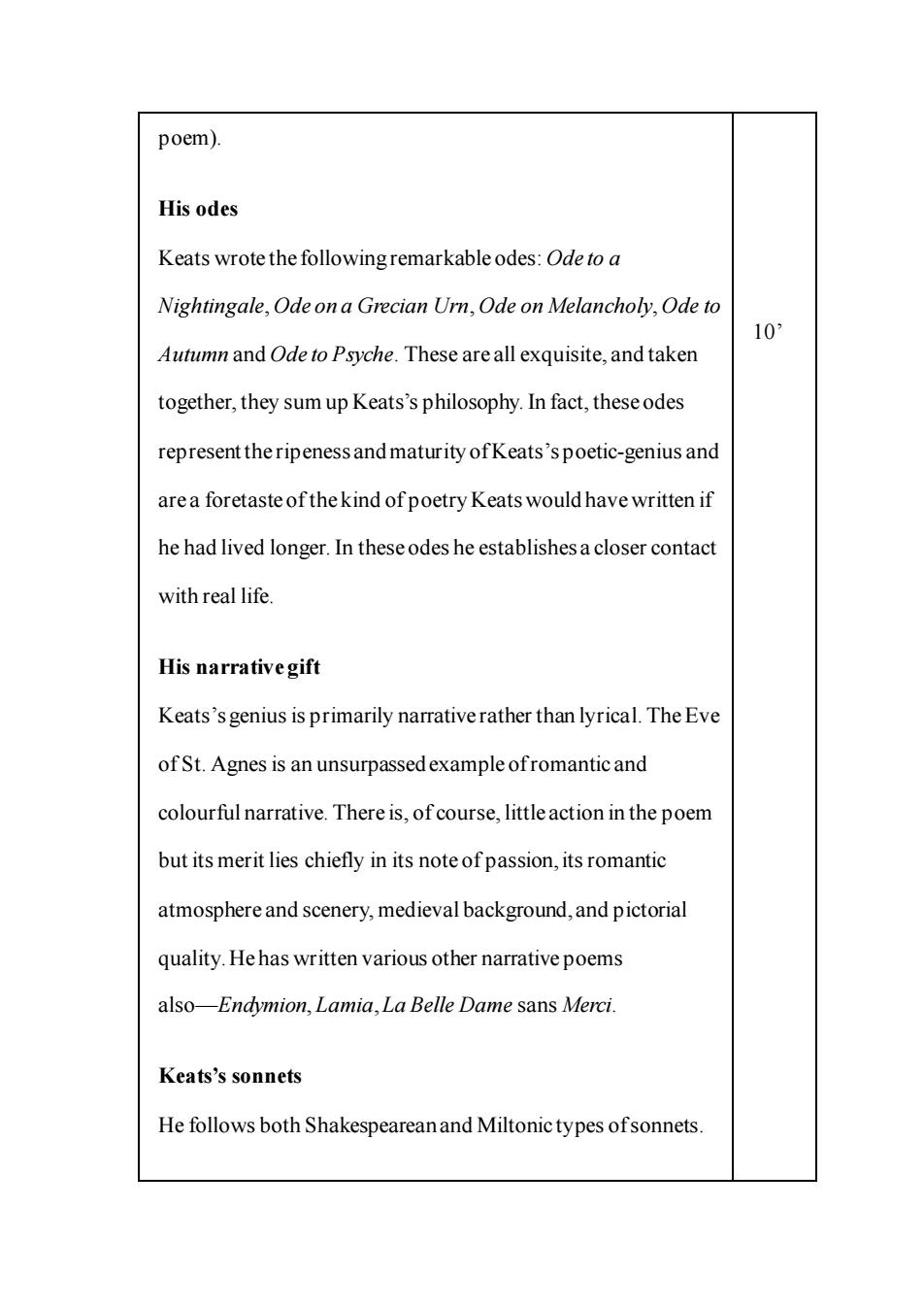
poem). His odes Keats wrote the followingremarkableodes:Ode to a Nightingale,Ode on a Grecian Urn,Ode on Melancholy,Ode to 10: Autumn and Ode to Psyche.These are all exquisite,and taken together,they sum up Keats's philosophy.In fact,theseodes represent the ripeness and maturity ofKeats's poetic-genius and are a foretaste of the kind of poetry Keats would have written if he had lived longer.In theseodes he establishesa closer contact with real life. His narrativegift Keats's genius is primarily narrativerather than lyrical.The Eve ofSt.Agnes is an unsurpassed example ofromantic and colourful narrative.There is,ofcourse,little action in the poem but its merit lies chiefly in its note ofpassion,its romantic atmosphere and scenery,medieval background,and pictorial quality.He has written various other narrative poems also-Endymion,Lamia,La Belle Dame sans Merci Keats's sonnets He follows both Shakespeareanand Miltonictypes ofsonnets
poem). His odes Keats wrote the following remarkable odes: Ode to a Nightingale, Ode on a Grecian Urn, Ode on Melancholy, Ode to Autumn and Ode to Psyche. These are all exquisite, and taken together, they sum up Keats’s philosophy. In fact, these odes represent the ripeness and maturity of Keats’s poetic-genius and are a foretaste of the kind of poetry Keats would have written if he had lived longer. In these odes he establishes a closer contact with real life. His narrative gift Keats’s genius is primarily narrative rather than lyrical. The Eve of St. Agnes is an unsurpassed example of romantic and colourful narrative. There is, of course, little action in the poem but its merit lies chiefly in its note of passion, its romantic atmosphere and scenery, medieval background, and pictorial quality. He has written various other narrative poems also—Endymion, Lamia, La Belle Dame sans Merci. Keats’s sonnets He follows both Shakespearean and Miltonic types of sonnets. 10’
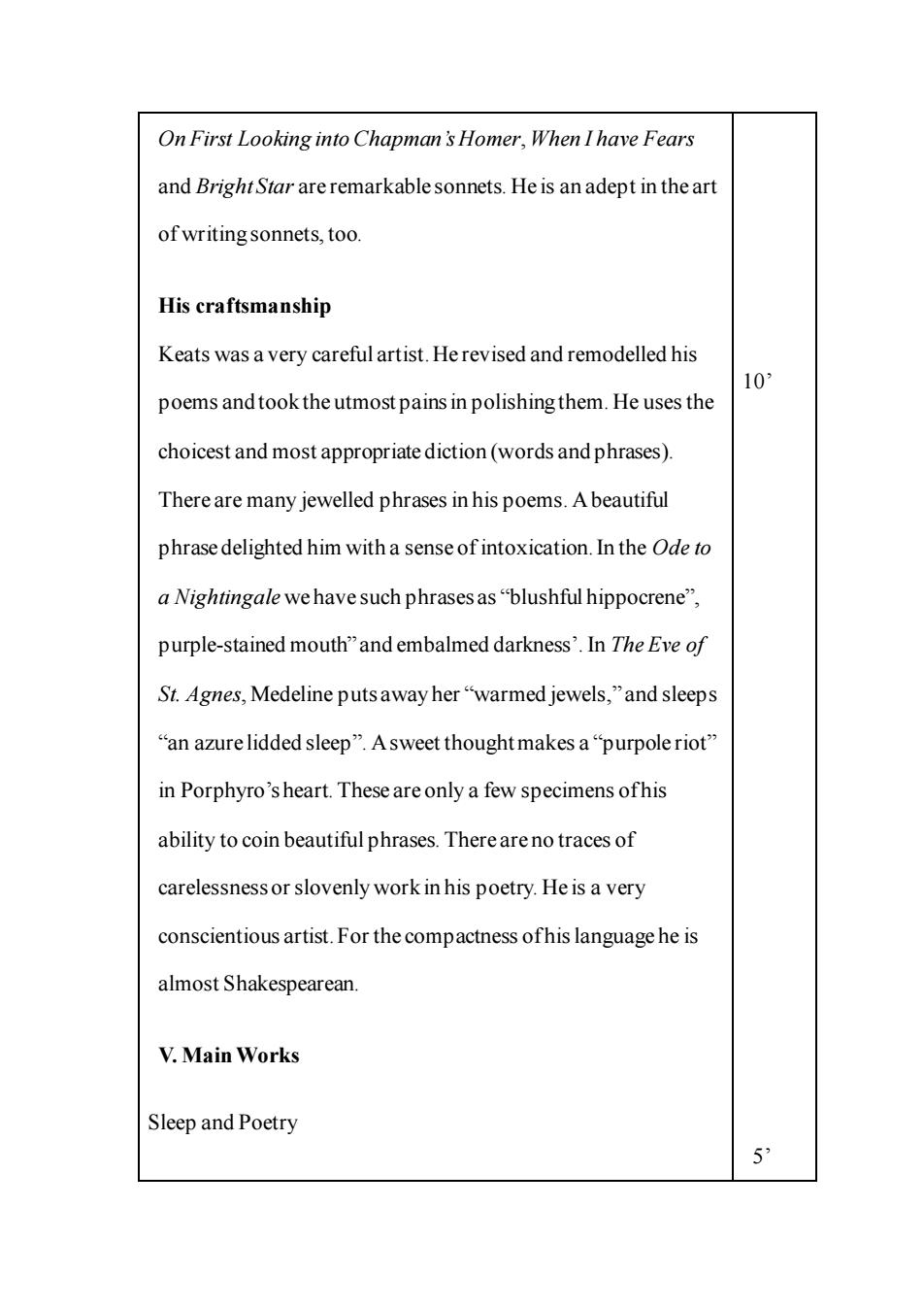
On First Looking into Chapman 's Homer,When I have Fears and Bright Star are remarkable sonnets.He is an adept in the art of writing sonnets,too. His craftsmanship Keats was a very careful artist.He revised and remodelled his 10° poems and took the utmost pains in polishing them.He uses the choicest and most appropriate diction(words and phrases). There are many jewelled phrases in his poems.A beautiful phrasedelighted him witha sense of intoxication.In the Ode to a Nightingale we have such phrasesas"blushful hippocrene", purple-stained mouth"and embalmed darkness'.In The Eve of St.Agnes,Medeline putsaway her"warmed jewels,"and sleeps "an azure lidded sleep".Asweet thoughtmakes a"purpole riot" in Porphyro's heart.These are only a few specimens ofhis ability to coin beautiful phrases.Thereare no traces of carelessness or slovenly work in his poetry.He is a very conscientious artist.For the compactness ofhis language he is almost Shakespearean V.Main Works Sleep and Poetry 5
On First Looking into Chapman’s Homer, When I have Fears and Bright Star are remarkable sonnets. He is an adept in the art of writing sonnets, too. His craftsmanship Keats was a very careful artist. He revised and remodelled his poems and took the utmost pains in polishing them. He uses the choicest and most appropriate diction (words and phrases). There are many jewelled phrases in his poems. A beautiful phrase delighted him with a sense of intoxication. In the Ode to a Nightingale we have such phrases as “blushful hippocrene”, purple-stained mouth” and embalmed darkness’. In The Eve of St. Agnes, Medeline puts away her “warmed jewels,” and sleeps “an azure lidded sleep”. A sweet thought makes a “purpole riot” in Porphyro’s heart. These are only a few specimens of his ability to coin beautiful phrases. There are no traces of carelessness or slovenly work in his poetry. He is a very conscientious artist. For the compactness of his language he is almost Shakespearean. V. Main Works Sleep and Poetry 10’ 5’